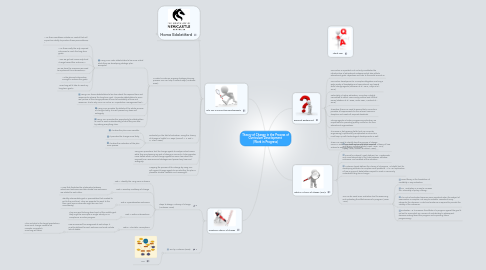
1. Creating a Theory of Change
1.1. Steps to design a Theory of Change (Anderson, 2005)
1.1.1. Task 1: Identify the Long-Term Outcome
1.1.2. Task 2: Develop a Pathway of Change
1.1.2.1. A map that illustrates the relationship between actions and outcomes and also shows how outcomes are related to each other.
1.1.3. Task 3: Operationalise Outcomes
1.1.3.1. Identify Intermediate-goal or precondition that needed to get to the next level. They are essential to reach to the main goal (some outcomes might be nice, but unnecessary).
1.1.4. Task 4: Define Interventions
1.1.4.1. They are used to bring about each of the middle-goal. they might be as simple as single activity or as complex as an entire program.
1.1.5. Task 5: Articulate Assumptions
1.1.5.1. How success will be recognised at each steps. It must be defined for each outcome and must include lots of details:
1.1.5.1.1. Who and what is the target population? How much change needs to be consider successful? How long will take?
1.2. ToC by Anderson (2005)
1.2.1. ToC
2. Why ToC in Curriculum Development?
2.1. The history of ToC (known as program theory) goes back to reforming in social systems.
2.1.1. Weiss (1995, p.69) argues that the reason for emphasis on reforming community-based systems is because it deals with different factors at the same time.
2.1.2. The same reason can be assigned for reforming and developing curriculum. Curriculum development interacts with multiple factors such as students attrition and retention, skill shortage, and universities' fund allocation.
2.2. In order to make an ongoing strategic planning process, ToC can help in several ways (Anderson, 2005):
2.2.1. Using TOC make stakeholders to be more critical while they are developing strategic plan. Examples:
2.2.1.1. "Are there conditions outside our control that will impact our ability to produce these preconditions? "
2.2.1.2. "Are these really the only required outcomes to reach the long-term goal?"
2.2.1.3. "Can we get real community-level change toward this outcome? "
2.2.1.4. 'Do we have the resources we need to implement this intervention?"
2.2.1.5. "Is the planned intervention enough to achieve the goal?"
2.2.1.6. "How long will it take to reach my long-term goal? "
2.2.2. Using TOC forces stakeholders to be clear about the required time and resources to achieve the long-term goal. It provides stakeholders to see a real picture of the change process in terms of availability of time and resources. That is why TOC can act as an "expectation management tool".
2.2.3. Using TOC provides the details of the whole process of change clearly. This will prevent any haze and ambiguity.
2.2.4. Using TOC provides this opportunity for stakeholders to reach a same understanding of what they are after by making everything clear.
2.3. Particularly in the field of education, using the Theory of Change is helpful in 3 ways (Connell, J. P. and A. M. Klem, 2000):
2.3.1. It makes the plan more sensible.
2.3.2. It provides the change more likely.
2.3.3. It makes the evaluation of the plan more precise.
2.4. Using ToC provides a tool for change agents to analyse critical issues while they are planning any sort of change in curricula. It also provides more details which can aid change agents be more clear about the required time, resources and strategies and prevent any haze and ambiguity.
2.5. Mapping the process of this change by using ToC will support change agents to see whether the plan is plausible, doable, testable, and meaningful.
3. Homa Edalatifard
4. What is a Theory of Change (ToC)?
4.1. ToC has been simply determined as a theory of how and why an initiative works (Weiss, 1995, 1972; Lipsey, 1993; Connell & Kubisch 1998).
4.2. Connell & Kubisch (1998) defines it as "a systematic and cumulative study of the links between activities, outcomes, and contexts of the initiative".
4.3. Anderson (2005) defines the Theory of Change as "a helpful tool for developing solutions to complex social problems." It is "an explanation of how a group of stakeholders expect to reach a commonly understood long-term change".
4.4. ToC can be used as an evaluation tool for examining and evaluating the effectiveness of a program (Weiss, 1972).
4.4.1. Good theory is the foundation of credibility in any evaluation.
4.4.2. So, "evaluation is a way to increase the rationality of policy making".
4.4.3. The role of evaluation become more important when the subject of examination is complex, not easy to evaluate, consists of many elements, the decisions is vital and evidence is required to provide the validity of the outcomes.
4.4.4. Evaluation "is to measure the effects of a program against the goal it set out to accomplish as a means of contributing to subsequent decision making about the program and improving future programming"
